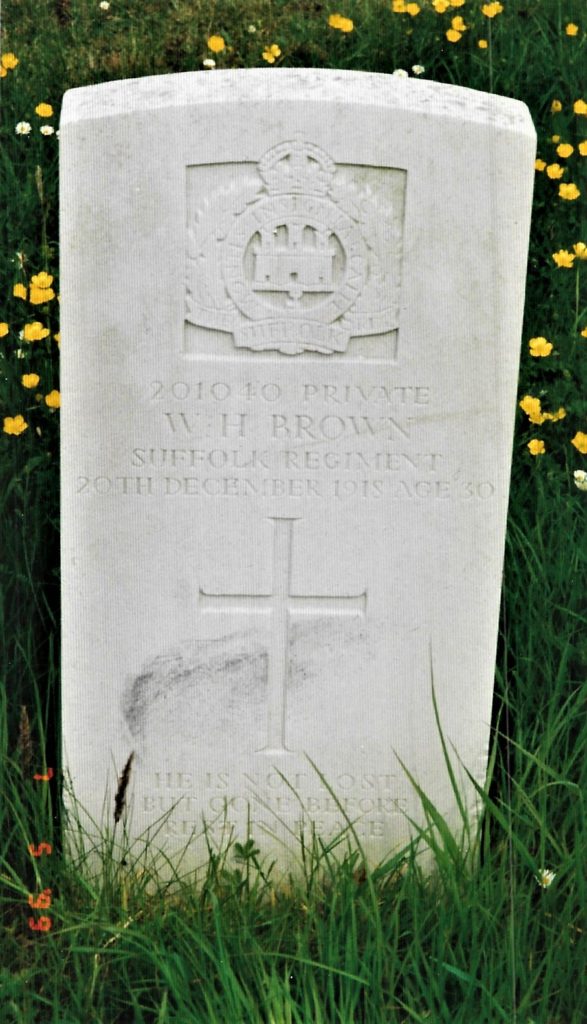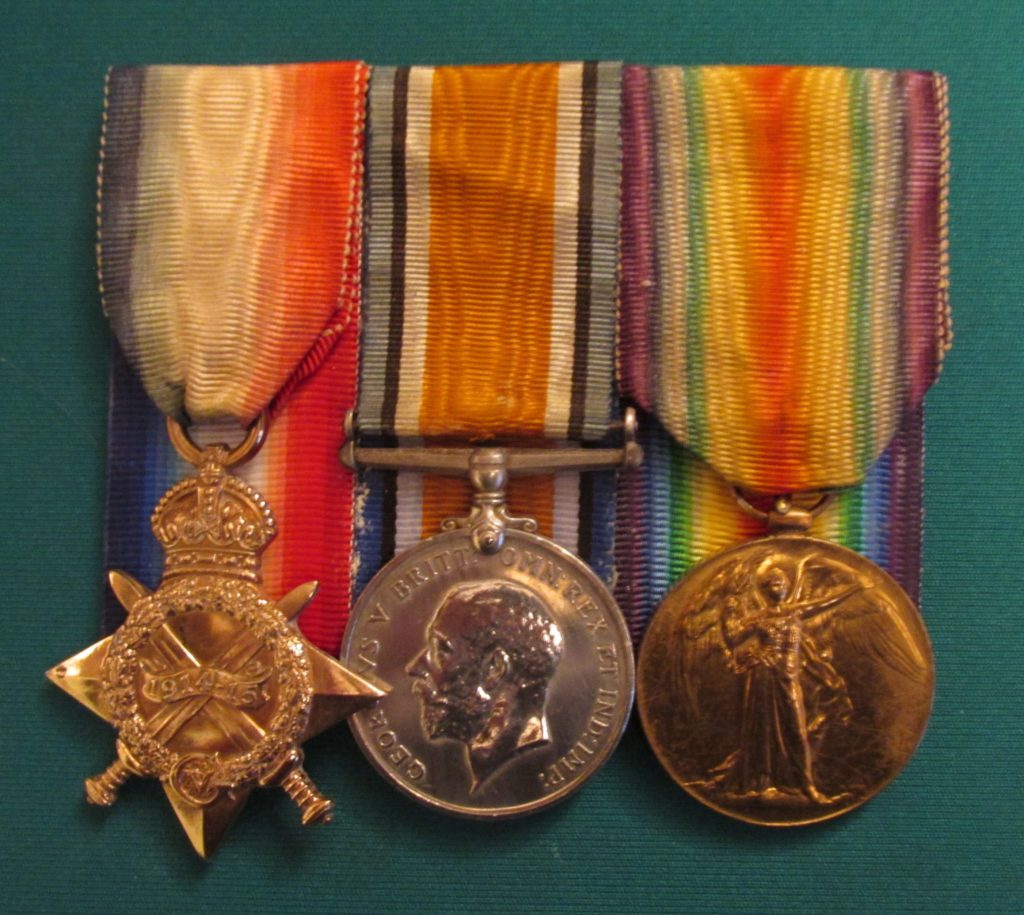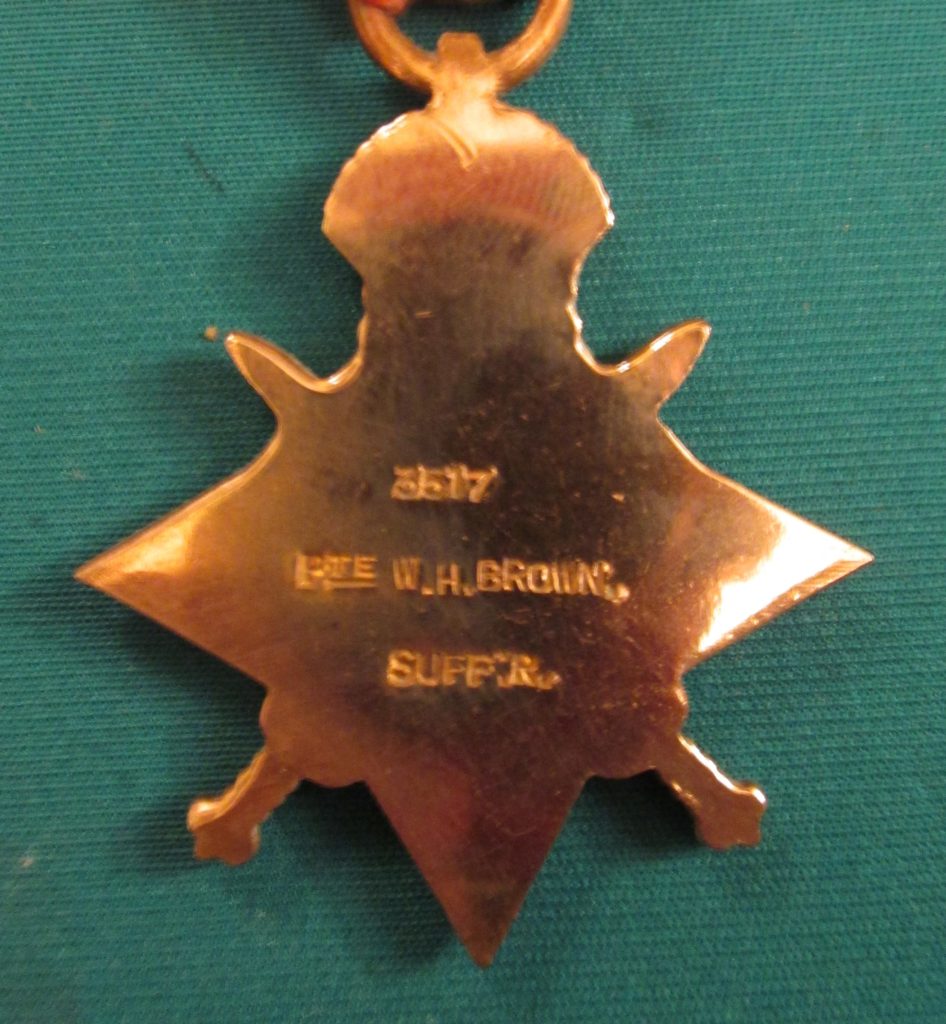201040 PRIVATE WILLIAM HERBERT BROWN
1/4TH BATTALION SUFFOLK REGIMENT T.F.
DIED OF PNEUMONIA
20TH DECEMBER 1918
AGED 30 YEARS

William had been born in the nearby village of Cookley in the third quarter of 1888, the fourth child of John, who had died shortly after William’s birth, and Pricilla (née Forster) who appeared to have had a very hard life. Apart from losing her husband, with three small children to bring up on her own, in 1893 her eldest son Francis, who had enlisted into the Royal Artillery in 1890, died of a fever whilst serving in India. By the time of the 1911 census William was the only one of her children still living with his mother at No.32 Chediston Street, Halesworth. At the start of World War 1, William, who had previously served in the town’s Territorials, eventually re-enlisted, leaving the employ of George Woods, family butcher of the Market Place.
In June 1915, he travelled to Bury Saint Edmunds, now with the regimental number of 3517, to join the 3/4th (Reserve) Battalion, Suffolk Regiment. There he underwent eighteen weeks of training. He was then posted once again to serve with his old Halesworth chums in ‘C’ Company, 1/4th Suffolks, joining them in France on the 27th October 1915. At this time, the Battalion had now joined the 15th Division, where they had settled down to trench routine in the area around the town of Raimbert, in Northern France. What records remain of his service shows that barely four months after arriving in France he was granted eight days home leave from the 20th February 1916. Why should this have been so when some of his comrades who had crossed over in November 1914 still had to receive leave? On his return he continued to serve in ‘C’ Company both in and out of the front line, now under the command of the 33rd Division. On the 2nd July 1916, the 1/4th Suffolk’s with their Division were relieved and sent post-haste to the Somme where, after the disastrous attack of the previous day, more experienced troops were required to prop up the line. The 1st July 1916 would go down in the history of the British Army as the costliest in the number of soldiers killed in any action on a single day, with nineteen thousand, two hundred and forty lives lost. On the 20th July, the battalion received orders to prepare to support an attack on the German positions in the area of High Wood. It was during this action that William received a gunshot wound to his right foot. On being found he was carried from the battlefield. Two days later he had been admitted to No.18 British General Hospital where he remained until early October. From here he was transferred to the 15th Infantry Base Depot situated at Etaples on the French coast, where he would be expected to recover from his wounds. Before returning to full fitness, it was while at the Depot that he would have received his new regimental number of 201040. This then brought the Territorials into line with the rest of the field armies numbering system. After many months of treatment and exercise William was finely classified as physically unfit for any further frontline service on the 7th August 1917, although not sufficiently to be discharged from the Army. On that day, a year after being wounded, William was posted to ‘F’ Battery, one of the new Anti-Aircraft units formed to protect Army Headquarters etc from air attack. Although the new units were classified as an arm of the Royal Garrison Artillery, William appears to have remained a member of the Suffolk Regiment. From the 13th November 1917 he was once more granted ten days home leave. On returning to France, he continued to serve right up to and beyond the Armistice on the 11th November 1918. Less than a month later he travelled home having been granted another fourteen days leave from the 8th December 1918.
After visiting his mother in Halesworth he then went on to meet his then fiancée, Maggie Read, who lived in Great Yarmouth, it was there that he was taken ill with pneumonia. After just five days he passed away, on the 20th December 1918. No doubt due to the advancing Christmas holidays, William was laid to rest with full military honours in the Halesworth town cemetery on Christmas Eve. The Halesworth Times of the 14th January 1919, reporting on William’s funeral, lists the mourners. Apart from members of William’s family, there were many from the town’s serving sailors and soldiers (who no doubt were also on leave) in attendance. Whether William’s death was attributed to his service is not known but a note on the Commonwealth War Graves Commission entry in the burial book for Halesworth cemetery lists him as having died of wounds (GAS). If this is the case, no records of this can be found.
To this day William’s military headstone can be seen in Section A Grave No.367.
By the 1st July 1919 Priscilla, William’s mother, now living in Hill Cottage, Walpole, had received a gratuity totalling £31.8s.4d (£31.42p).
Also, on his death, Priscilla, being his next of kin, would have received his medal entitlement of the 1915 Star Trio with Memorial Plaque and Scroll.
William’s 1915 Star medal trio is now in a private collection, while the Memorial Plaque and Scroll’s location remains unknown.



This postcard shows a typical anti-aircraft section that William would have joined in 1917
